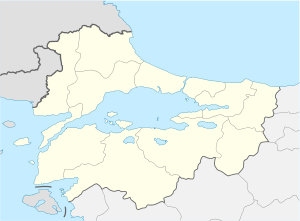Eceabat
Eceabat, formerly Maydos (Madytos, Greek: Μάδυτος), is a town and district of Çanakkale Province in the Marmara region of Turkey, located on the eastern shore of the Gelibolu Peninsula, on the Dardanelles Strait. According to the 2010 census, population of the district is 9,154 of which 5,380 live in the town of Eceabat.[3][4] The district covers an area of 468 km2 (181 sq mi),[5] and the town lies at an elevation of 0 m (0 ft).
Eceabat | |
|---|---|
District | |
Kilitbahir Castle built by Mehmed II Fatih in 1452 | |
 Location of Eceabat within Turkey. | |
 Eceabat Location of Eceabat  Eceabat Eceabat (Turkey) | |
| Coordinates: 40°11′N 26°21′E | |
| Country | |
| Region | Marmara |
| Province | Çanakkale |
| Government | |
| • Mayor | Saim Zileli (İyi Party) |
| Area | |
| • District | 468.32 km2 (180.82 sq mi) |
| Elevation | 0 m (0 ft) |
| Population (2012)[2] | |
| • Urban | 5,380 |
| • District | 8,993 |
| • District density | 19/km2 (50/sq mi) |
| Time zone | UTC+2 (EET) |
| • Summer (DST) | UTC+3 (EEST) |
| Postal code | 17xxx |
| Area code(s) | 286 |
| Licence plate | 17 |
| Website | www.eceabat.bel.tr |
Eceabat has been used as a departure point for people swimming the Hellespont to Çanakkale on the other side of the Dardanelles Strait.
Eceabat is the nearest town to the World War I Gallipoli Campaign battlefields of 1915, cemeteries and memorials to the more than 120,000 soldiers fallen from Turkey, the United Kingdom, France, Australia and New Zealand. The name Eceabat could be originated from the Arabic military word "Hijabat" which means the most forward command point from the battlefield; this could also explain the change from the original name Madytos.
On 1914, there were many attacks from Turks (including Turkish soldiers), against Greek citizens of Madytos. Many of the attacks were lethal. On 17 April 1915, the town was evacuated in the space of five hours. Turks plunder organized the property of the Greek population, despite the promise of Essad Pasha to the Greek Metropolitan that the Christian properties would be respected. The Greeks deprived of everything they had, sojourning four days in the mountains and then were embarked and dispatched to the diocese of Cyzicus. Many of them died from the hardship. These measures were part of the ongoing persecution of Greeks in the Ottoman Empire at the time. On 1916, a Greek woman of Madytos was raped by eighteen Turkish soldiers.[6]
Notes
- "Area of regions (including lakes), km²". Regional Statistics Database. Turkish Statistical Institute. 2002. Retrieved 5 March 2013.
- "Population of province/district centers and towns/villages by districts - 2012". Address Based Population Registration System (ABPRS) Database. Turkish Statistical Institute. Retrieved 27 February 2013.
- Statistical Institute
- GeoHive. "Statistical information on Turkey's administrative units". Retrieved 20 April 2009.
- Statoids. "Statistical information on districts of Turkey". Retrieved 20 April 2009.
- Persecution of the Greeks in Turkey, 1914-1918. Constantinople [London, Printed by the Hesperia Press]. 1919.
References
- Falling Rain Genomics, Inc. "Geographical information on Eceabat, Turkey". Retrieved 19 April 2009.
External links
![]()
- District governor's official website (in Turkish)
- Road map of Eceabat and environs
- Various images of Eceabat, Çanakkale
- Eceabat